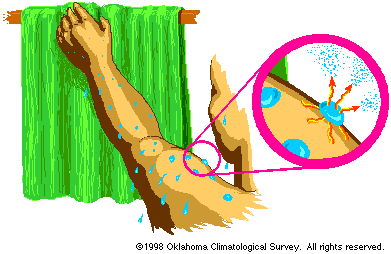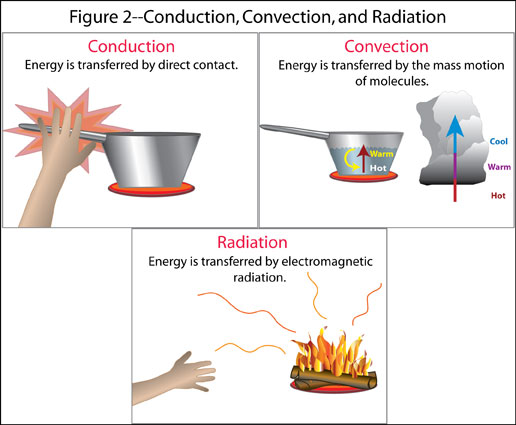|  |
| | Heat Transfer |
| | | |
| | Principle | The driving force for atmospheric motion is the dominicus and, in particular, the uneven distribution of solar radiation across the earth. It is the primary job of the atmosphere to redistribute energy in order to achieve a remainder from pole to equator. We need to understand methods of heat exchange in the temper to capeesh how the thin temper keeps u.s. alive. |
| | | |
| | Energy | |
| | | |
| | Figure i- Evaporation and Condensation |
| |  |
| | Latent Oestrus | - Latent oestrus is the heat energy required to change a substance from one state to another.
There are basically iii states of matter: solid, liquid, and gas. The difference betwixt them is how the molecules are arranged. Solids have tightly-packed molecules, liquids are withal bound together but not strongly enough to go on them from flowing, and gas molecules are free-flowing, non spring to one some other at all. Energy is required to modify from one country to another considering bonds must exist loosened, broken, tightened, or made. Energy must exist given to the molecules if bonds are to be loosened or broken and taken from the molecules if they are to be tightened or made. - Free energy is required to change from solid to liquid, liquid to gas (evaporation), or solid to gas (sublimation). Energy will exist released to modify from liquid to solid (fusion), gas to liquid (condensation), or gas to solid.
- Latent rut of evaporation is the free energy used to change liquid to vapor.
IMPORTANT: The temperature does not change during this process, and so heat added goes directly into changing the state of the substance. About 600 calories of energy are needed for every gram of water at room temperature. This is why you cool when you lot step out of the shower. Heat is taken from your skin to evaporate the water on your body. - Evaporation is a cooling procedure.
- Latent oestrus of condensation is energy released when water vapor condenses to form liquid aerosol.
An identical amount of calories (nigh 600 cal/g) is released in this process every bit was needed in the evaporation process. This is one mechanism of how thunderstorms maintain their intensity. As moist air is lifted and cooled, water vapor eventually condenses, which then allows for huge amounts of latent heat energy to be released, feeding the storm. - Condensation is a warming process.
- Latent heat of fusion describes both irresolute from solid to liquid and from liquid to solid.
From solid to liquid, almost 80 calories per gram are needed. From liquid to solid, about 80 cal/one thousand are released. - Latent heat of sublimation describes both changing from solid to gas and gas to solid.
Sublimation is rare equally compared to the other changes of state. From solid to gas 600 + eighty = 680 calories per gram are needed. From gas to solid, 680 cal/grand are released. |
| | | |
| | Figure 2- Conduction, Convection and Radiation |
| |  |
| | Methods of Rut Transfer | - Conduction- energy is transferred by the straight contact of molecules, not past the motion of the textile
Case: putting your hand on a stove burner. The amount of energy transferred depends on how conductive the material is. Metals are good conductors, so they are used to transfer free energy from the stove to the food in pots and pans. Air is the best insulator, so proficient insulating products endeavor to trap air and not let it to move. - Convection- energy is transferred by the mass movement of groups of molecules resulting in transport and mixing of backdrop
Instance: holding your hand over a stove burner. In meteorology, nosotros speak of convection predominantly every bit that caused by ascent currents of warm air. We refer to all other mass motions of air as advection. - Radiation- energy is transferred by electromagnetic radiations
Example: oestrus felt when standing abroad from a large fire on a calm night. Everything that has a temperature above absolute nothing radiates energy. Radiation is not "felt" until it is captivated past a substance. It does not require a medium to transfer energy through every bit do conduction and convection. |
| | | |
| | Specific Heat | - Specific estrus is the amount of estrus needed to enhance the temperature of one gram of a substance i degree Celsius.
- The specific heat of water is very high compared to other substances, so water can store energy longer than nearly other substances.
For case, the Gulf of Mexico remains warm during the dark, when air and soil temperatures decrease rapidly. Why is the Southern Hemisphere summer generally not warmer than the Northern Hemisphere summer although Earth is closer to the sun during the Southern Hemisphere summer? Because most of the Southern Hemisphere is water, which regulates the seasonal temperatures. |
| | | |
| | End | |
|
 |
| OK-FIRST Project , Oklahoma Climatological Survey , 100 E Boyd Street, Suite 1210, Norman, OK 73019.
Copyright © 1996-2005 Oklahoma Climatological Survey. All Rights Reserved.
Send comments or questions concerning OK-Beginning to okfirst@mesonet.org |
chotheinguing.blogspot.com
Source: https://okfirst.mesonet.org/train/meteorology/HeatTransfer.html


0 Response to "what happens to matter when latent heat is released or absorbed"
Post a Comment